Panasonic Lumix DMC-LX5 Review
Panasonic Lumix DMC-LX5 Introduction
The Panasonic Lumix DMC-LX5 is an advanced compact digital camera with a bright ultra-wide-angle lens, equivalent to 24-90mm F/2-3.3. This advanced camera features a larger-than-usual 10 megapixels CCD capable of ISO 80 to 3200 at full resolution. It can record 720p HD video and shoot continuously at 2.5 FPS.
The LX5 is designed for advanced users looking for efficient manual controls in a compact camera. This can be photographers needed a compact model where larger equipment is cumbersome or beginners looking to learn photography. For either type of user, this digital camera offers full manual-controls including manual-focus and custom white-balance.
This camera has provides more external controls and expansion options than most fixed-lens cameras. There is a hot-shoe for external lighting and an accessory port that supports an optional EVF to allow eye-level shooting. A removable ring around the lens provides support for conversion lenses and filters via an optional adapter.
This camera review covers the features, usability and performance of the Panasonic Lumix DMC-LX5.
Panasonic Lumix DMC-LX5 Features
Sensor & Exposure
- 10 Megapixels CCD sensor
- ISO 80 to 3200 sensitivity at full-resolution
- ISO 6400 to 12800 at 3 megapixels
- Auto ISO based on light-levels and movement
- 1/4000-60s Shutter-speeds
- PASM Exposure modes for both stills and video
- Exposure-Compensation, ±3 in 1/3 EV increments
- Multi-Segment, Center-Weighed and Spot metering
Lens
- 3.8X Optical zoom range
- F/2-3.3 - 8 Aperture range
- Ultra-Wide-Angle 24-90mm equivalent
- Optical image stabilization
- 50cm Normal minimum focus
- 1cm (W) - 30m (T) Macro minimum focus distance
Image Parameters
- Automatic, 5 presetsDaylight, Cloudy, Shade, Flash, Incandescent, Kelvin and custom white-balance, 2 memories
- WB fine-tuning, 19 steps along 2 axis
- White-Balance bracketing, 3 frames
- Standard, Dynamic, Nature, Smooth, Vibrant and Nostalgic color modes
- Standard, Dynamic & Smooth BW modes
- Adjustable Contrast, Sharpness, Saturation, Noise-Reduction, 5 steps each
- Optional High-ISO Noise-Reduction (1600-3200)
- JPEG Image or RAW File output
Focus
- Normal, Macro and Manual focus modes
- Single, Automatic, Tracking and Face-Detect focus-point selection
- Prefocus: Off, Quick or Continuous
- Manual Focus assist
- AF Assist-Lamp
Drive
- Single-shot
- Self-Timer, 2s or 10s
- 2.5 FPS, Maximum 3 frames
- Exposure Bracketing, 3 frames, maximum ±3 EV
- Aspect Ratio Virtual Bracket, always 4 frames
- Multiple-Exposure, maximum 3 frames, optional Auto-Gain
Display & Viewfinder
- 3" LCD, 460K Pixels
- Optional 0.2" EVF, 200K Pixels
- Adjustable LCD brightness
- Adjustable LCD contrast-saturation
- Adjustable LCD colors
- Optional framing grid
Video
- 1280x720 @ 30 FPS in AVCHD or Motion-JPEG
- AF-S or AF-C focus
- Optional wind-filter
- Optional stabilization
Flash
- Flash-Compensation, ±2 in 1/3 EV increments
- Auto, Auto Redeye, Forced, Redeye & Slow-Sync flash modes
- First or Rear curtain flash sync
- Optional Redeye reduction
- Flash Hot-Shoe
Connectivity
- Stereo Sound input
- HDMI (1080i) output
- A/V (NYSC / PAL) output
- USB 2.0 connectivity
Misc
- 4:3 (Native), 3:2, 16:9 & 1:1 Aspect-Ratio
- Combined AE-L/AF-L button
- Customizable Fn button
- Panorama Assist Mode
- 22 Scene Modes
- Face Recognition
- Lithium-Ion battery
- SDXC memory
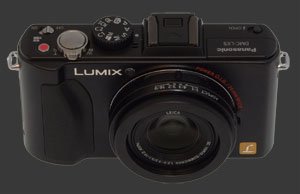
NOTE The Panasonic Lumix DMC-LX5 tested here is equipped with Firmware version 2.0 which was released on September 15, 2011. This improves performance and can be obtained as a free upgrade for existing LX5s.
Panasonic Lumix DMC-LX5 Usability - How easy is it to use?
The Panasonic Lumix DMC-LX5 has a compact and comfortable shape thanks to a small rubberized grip. It has a short protruding lens barrel from which the lens extends out about 1" when powered on. The lens is normally protected by a removable lens cap which can be tethered to a camera-strap eyelet. There are eyelets on both sides for the supplied neck-strap. Given its small size, the LX5 can be easily used with a wrist-strap instead.
On top, a small sliding power-switch turns on the camera. Above it, a dedicated video-recording button starts filming but is redundant since there is a dedicated Movie mode which uses the shutter-release to start and stop. Filming in all other modes is possible but shows the wrong framing unless an option is selected in the Setup menu. When that option is selected, then the wrong framing is shown for stills. So, we recommend it being left alone and video mode be used when needed.
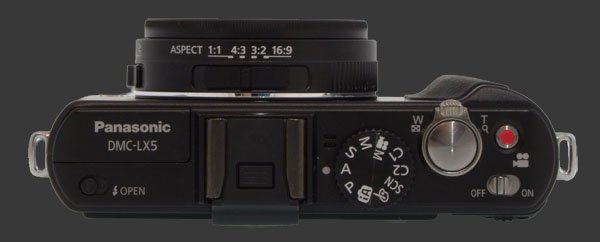
A standard two-stage shutter-release with a distinct halfway point is found next to the video-recording button. Around it is the zoom controller which moves the lens at a leisurely pace in 19 fine-increments. To the left of it is a traditional mode dial with good audible detents. All PASM modes are there, plus iAuto, My Color mode, Scene mode, 2 Custom modes and Movie mode. Movie mode has PASM sub-modes too.
The combined hot-shoe and accessory port are under a plastic cover. External lighting can be attached to the hot-shoe or an optional 0.2" EVF with 200K pixels. Needless to say, using the EVF prevents using any external lighting. Further left is the flash-release button which works exactly as expected.
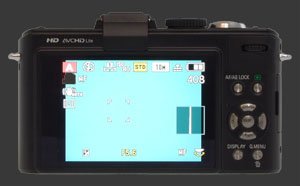 The rear of the LX5 is dominated by a 3" LCD with 460K pixels. The LCD is sharp with an excellent anti-reflective coating. The LCD is highly customizable and can be calibrated in terms of Tint along 2 axis in 11 fine. Display Contrast and Saturation are adjustable together in 7 steps, as is brightness. It is great to see this functionality on a compact camera. Plus, the review unit required some correction to show neutral colors.
The rear of the LX5 is dominated by a 3" LCD with 460K pixels. The LCD is sharp with an excellent anti-reflective coating. The LCD is highly customizable and can be calibrated in terms of Tint along 2 axis in 11 fine. Display Contrast and Saturation are adjustable together in 7 steps, as is brightness. It is great to see this functionality on a compact camera. Plus, the review unit required some correction to show neutral colors.
The rear LCD shows a bright view of the subject until the shutter-release is pressed halfway when it becomes Exposure-Priority temporarily. When the Live-Histogram is shown, it is always calculated from the displayed brightness, making it useless until the shutter-release is pressed halfway. While it would be preferable to always have an Exposure-Priority display, the histogram should only be shown when correct. Instead, it simply turns orange while occluding part of the frame, making it worse than useless. At least it can be turned off completely.
The remaining area to the right of the LCD is mostly covered with controls, leaving a small spot below the control-dial to place the thumb. The only control-dial is clickable so that it can be cycled between several functions. While this saves the space needed for another dial, it is fiddly and error-prone since camera operations are modal.
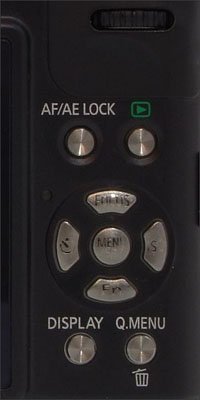 Further below the control-dial, there is a 4-way controller made of 5 separate buttons including the central OK. The controller is used to navigate menus and activate important functions:
Further below the control-dial, there is a 4-way controller made of 5 separate buttons including the central OK. The controller is used to navigate menus and activate important functions:
- Up: Enters focus area control mode. In this mode the directions move the focus area around until OK is pressed.
- Right: Selects the ISO. There are 2 automatic options, one depending on light levels and the other, called Intelligent ISO, depending on light and subject movement.
- Down: Activates a user-defined function. There are 12 functions to choose from including Metering and White-Balance which are probably the most useful ones.
- Left: Cycles over Self-Timer options: Off, 2s or 10s. Annoyingly Self-Timers constantly get reset by the camera. Not only after each use but also when entering the menu system or changing exposure modes.
There two buttons above and two below the 4-way controller. The ones above are the customizable AE-L/AF-L and Playback buttons. Below are the Display and Quick Menu buttons. AE-L/AF-L can lock exposure, focus or both. The Quick Menu button enters a graphic menu to change Color Mode, Flash Mode, Continuous Drive, Metering Mode, AF Mode, White-Balance, Image Resolution, Video Resolution and LCD Mode. By the way, the display of WB options is slower but less intrusive with the Quick Menu than through the customizable Function button.
There are two more controls on the lens barrel of this digital camera. On top is the Aspect-Ratio slider which selects between 4 aspect ratios: 1:1, 4:3, 3:2 and 16:9. The CCD used has a native aspect ratio of 4:3 that is circumscribed in the imaging circle of the lens, so all other aspect ratios lose resolution. On the side is a 3 way switch to choose between Normal AF, Macro AF and Manual Focus.
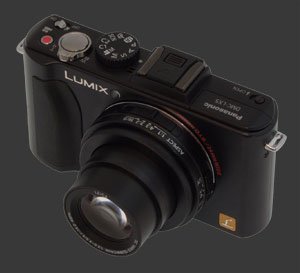
Manual Focus is adjusted via the control dial. There is a MF Assist mode which enlarges the center of the image but it barely helps. Magnification and LCD resolution are too low, so fine changes are difficult to judge.
The bottom of the LX5 has a rather poorly placed tripod mount and a flimsy door covering the combined battery and SDXC card compartment. The remainder of the camera is actually well-built and feels solid though.
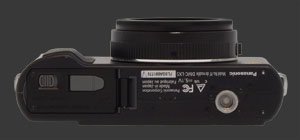
Panasonic Lumix DMC-LX5 Performance - How well does it take pictures?
Choosing a digital camera is all about results: Getting the image quality you need and photographs the way you like them. Compact digital cameras generally have it tough because they suffer from small sensors and limited controls. The Panasonic Lumix DMC-LX5 is made to address these two concerns while maintaining the size of a compact camera.
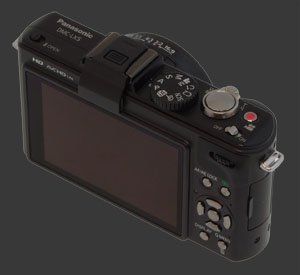 The LX5 uses a larger than usual CCD for its imaging sensor. At 10 MP, this gives it lower than average image noise and within 1 stop or so from similar compacts. Image noise is further suppressed by a sophisticated noise-reduction system which retains a good amount of details from ISO 100 to 400. A gradual increase of softness is noticeable above that, reducing maximum print sizes for each additional sensitivity stop.
The LX5 uses a larger than usual CCD for its imaging sensor. At 10 MP, this gives it lower than average image noise and within 1 stop or so from similar compacts. Image noise is further suppressed by a sophisticated noise-reduction system which retains a good amount of details from ISO 100 to 400. A gradual increase of softness is noticeable above that, reducing maximum print sizes for each additional sensitivity stop.
With the new firmware, additional noise-reduction is available for ISO 1600 and 3200. This cleanup ISO 1600 nicely and leaves it usable for small prints. ISO 3200 remains borderline usable for emergencies but this is a great performance from a fixed-lens camera.
Colors of the LX5 are its most problematic area for those shooting JPEG images. Despite numerous film modes and parameters, colors never get entirely real. Best results are obtained by Standard film mode with Saturation set to -1. There are slight over-sharpening artifacts at the default sharpness, but are only visible in relatively large prints. Noise-reduction settings are fine-grained and all give very similar results, staying in the -2 to 0 range is probably best.
The other part of color rendition is white-balance. The Automatic White-Balance system on the LX5 shows its age and constantly struggles, leaving strong color casts in the presence artificial lighting. Custom WB does work very well though, so the AWB issue is avoidable.
The Multi-Segment metering system of this digital camera is reasonably good and very consistent. It seems to blow out highlights by up to one stops in low-light which makes it less conservative than ideal but tends to produce more print-ready results. Dynamic range of the LX5 is on the limited side which is why it gets into trouble exposing scenes at night.
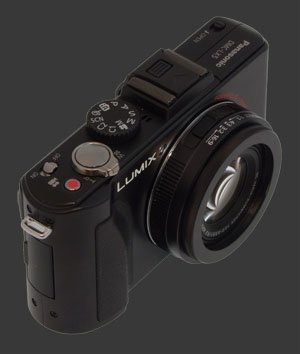 The ace-in-the-sleeve of the LX5 is its bright F/2 lens. While most cameras performing similarly start at F/2.8, this digital camera can shoot at one ISO less under the same conditions, recovering the slight advantage of its peers. The lens itself performs very well optically which slightly visible barrel distortion at wide-angle but no sign of vignetting or chromatic aberrations.
The ace-in-the-sleeve of the LX5 is its bright F/2 lens. While most cameras performing similarly start at F/2.8, this digital camera can shoot at one ISO less under the same conditions, recovering the slight advantage of its peers. The lens itself performs very well optically which slightly visible barrel distortion at wide-angle but no sign of vignetting or chromatic aberrations.
The lens zooms in from an ultra-wide 24mm at F/2 to a short telephoto 90mm at F/3.3 in 3 seconds which is rather slow. It does so in fine increments, making framing more precise than most electronic lenses. It takes just under 3s to power up and extend the lens which is also on the slow side. Shutting down takes about 2s.
Once on, the Lumix LX5 is generally quite responsive. The camera starts reacting immediately to most button presses. Autofocus takes between ½s and 1s under most cases with the Quick-AF option on. This is decent but not class leading. It can easily take longer though in low-light. Once focused the shutter-lag is barely noticeable but there is normally a black-out time of about 1s before the preview appears again. At low shutter-speeds, the LX5 applies additional noise-reduction which causes a 3s delay between frames while showing a blank screen with a countdown. There is also a two second lag to start video recording, making missing action a definite possibility.
Entering Playback mode takes about 1½s but exiting is instant. The LX5 is shooting priority, so a half-press of the shutter-release brings it back to shooting mode. If the camera recently entered Playback mode, this is quick. However, if it had time to retract the lens, expect another delay of about 1½s. Panning and zooming speeds are average.
The LX5 exhibits good battery-life for its class, with a quoted 400 shots-per-charge according to the CIPA standard. This should be sufficient for most days of shooting. Not using the built-in flash extends this further.
Panasonic Lumix DMC-LX5 Conclusion
The Panasonic Lumix DMC-LX5 is one of the few cameras aimed at the middle ground between P&S models and DSLR cameras. Its body and fixed lens makes it closer to compacts yet it manages to surpass them by combining a larger sensor and bright lens. Image quality overall is rather good, particularly when shooting RAW, and the camera performs reasonably well in terms of speed.
The LX5 offers a rich feature-set, including optional EVF and Hot-Shoe. Its lens has versatile ultra-wide to short telephoto reach with excellent optical quality. Most importantly, this digital camera offers plenty external controls to make operating it more efficient, something which is highly important for advanced users.
The sum of all this is a well-built compact camera with advanced features that fills its promise well and can be easily recommended as an excellent digital camera for creative photography.
 |
Please Support Neocamera
All information on Neocamera is provided free of charge yet running this website is a huge endeavor. Purchases made via affiliate links found throughout the site help keep it running and up-to-date. There is no additional cost to you, so please consider buying via these links to our affilates:
Thank you for your support!
Panasonic DMC-LX5 Highlights
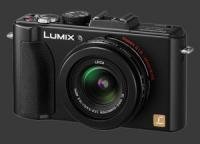
Sensor-Size: 8 x 6mm

Actual size when viewed at 100 DPI
| 10 Megapixels Fixed Lens | ISO 80-3200 |
| 3.8X Ultra-Wide Optical Zoom | Shutter 1/4000-60s |
| Built-in Stabilization | Full manual controls, including Manual Focus |
| 0.20" Optional EVF 200K Pixels (0.52X) | Custom white-balance with 2 axis fine-tuning |
| 2.5 FPS Drive, 4 Images | Spot-Metering |
| 1280x720 @ 30 FPS Video Recording | Hot-Shoe |
| 3" LCD 460K Pixels | Lithium-Ion Battery |
| Secure Digital Extended Capacity, Internal Memory |
Updates
2025.11.13

Best Gifts for Photographers in 2025 by Budget
The annual Neocamera Photography Gift Guide updated to 2025. Find great gifts for photographers with any price budget.
2025.07.07

Stellar Photo Recovery Review
Review of Stellar Photo Recovery V12. This Windows and MacOS software can recover photos and videos in a huge number of formats from memory cards, USB drives, SSDs and HHDs.
2025.05.14

Huion Kamvas 13 Gen 3 Review
In-Depth review of the Huion Kamvas 13 Gen 3 Pen Display Tablet for photographers and graphic artists.
2025.01.18

Fujifilm GFX 2025 Lens Roundup
Lens Review roundup of Fujifilm GFX Medium-Format lenses. Quality, performance and handling of the GF20-35mm F/4R WR, GF30mm F/3.5 Tilt-Shift and the GF55mm F/1.7.
2024.11.18

Best 2024 Photography Gifts for Every Budget
Great gifts for photographers and photo enthusiasts selected for every budget among the best products of 2024.
2024.08.07

Eye Protection Tips for Professional Photographers
The four main considerations for professional photographers regarding eyewear.
2024.07.14

Fujifilm X100VI Review
Flagship fixed-lens compact digital camera with a 40 MP sensor and Image-Stabilization, a first for the series. Retro design featuring dual control-dials, plus direct ISO, Shutter-Speed and EC dials. Its hybrid viewfinder can switch between EVF and OVF mode.
2024.05.09

Fujifilm GFX100 II Review
Flagship 102 Megapixels Medium-Format Mirrorless Digital Camera with 8-Stop 5-Axis IBIS, 8 FPS Drive, 8K Video and 400 MP Super-Resolution capture in a weatherproof and freezeproof body with dual control-dials and dual memory-card slots.
2024.04.03

Fujifilm X-T5 Review
Newest Fujifilm flagship boasting a 40 MP APS-C sensor, 5-axis IBIS with 7-stop efficiency, 15 FPS continuous drive, 6.2K Video capture, dual control-dials and dual SDXC UHS-II slots in a sturdy weatherproof and freezeproof body.
2023.11.20

Best Digital Cameras of 2023
Find out which are the Best Digital Cameras of 2023. All the new Mirrorless Digital Cameras from entry-level to high-end professional.
2023.07.10

Fujifilm X-H2 Review
40 Megapixels APS-C Hybrid Mirrorless Digital Camera with 7-stop IBIS. Fastest shutter ever and 8K video capture. Large builtin EVF with 0.8X magnification and 5.8 MP, plus an Eye-Start Sensor. Packed with features and large number of controls in a weatherproof and freezeproof body.
2023.05.07

Sony FE 20-70mm F/4G Review
Review of the unique Sony FE 20-70mm F/4G lens. The optical zoom of this lens spans ultra-wide-angle and medium focal-length coverage, making it one of the most versatile Full-Frame lenses on the market.












